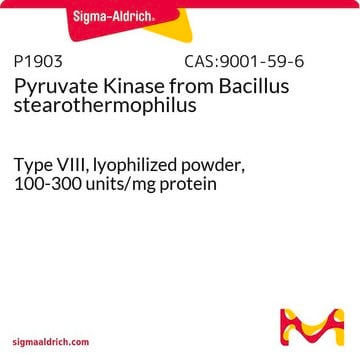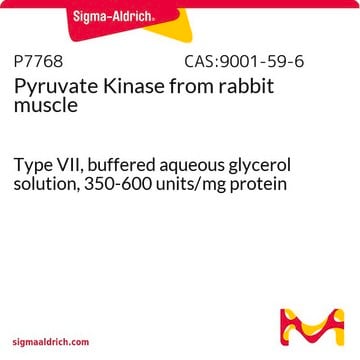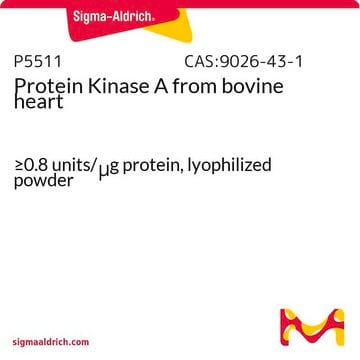P2014
Phosphorylase Kinase from rabbit muscle
lyophilized powder, ≥60 units/mg protein
Synonym(s):
ATP:phosphorylase-b phosphotransferase, Dephosphophosphorylase kinase
Sign Into View Organizational & Contract Pricing
All Photos(1)
About This Item
CAS Number:
MDL number:
UNSPSC Code:
12352204
NACRES:
NA.54
Recommended Products
form
lyophilized powder
specific activity
≥60 units/mg protein
composition
Protein, 20-40% biuret
foreign activity
ATPase ≤0.5%
phosphorylase a ≤1%
phosphorylase b ≤5%
storage temp.
−20°C
General description
Phosphorylase kinase contains four subunits each containing an α, β, γ, and sigma component. The sigma component binds 4 calcium molecules and is termed calmodulin while the γ unit acts as the catalytic subunit.
Application
Phosphorylase kinase from rabbit muscle has been used in a study to assess features of glycogen phosphorylase. It has also been used in a study to investigate the activation of different forms of muscle phosphorylase kinase by actin.
Unit Definition
One unit will form 1.0 μmolar unit of phosphorylase a from phosphorylase b per min at pH 7.7 at 30°C in the presence of ATP.
Physical form
Lyophilized powder containing (NH4)2SO4, sucrose, β-glycerophosphate and dithioerythritol
Storage Class Code
11 - Combustible Solids
WGK
WGK 3
Flash Point(F)
Not applicable
Flash Point(C)
Not applicable
Personal Protective Equipment
dust mask type N95 (US), Eyeshields, Gloves
Choose from one of the most recent versions:
Certificates of Analysis (COA)
Lot/Batch Number
Don't see the Right Version?
If you require a particular version, you can look up a specific certificate by the Lot or Batch number.
Already Own This Product?
Find documentation for the products that you have recently purchased in the Document Library.
Monica Balsera et al.
Planta, 237(2), 619-635 (2012-12-12)
Uncovered in studies on photosynthesis 35 years ago, redox regulation has been extended to all types of living cells. We understand a great deal about the occurrence, function, and mechanism of action of this mode of regulation, but we know little
Eijiro Ozawa
Proceedings of the Japan Academy. Series B, Physical and biological sciences, 87(8), 486-508 (2011-10-12)
It had long been one of the crucial questions in muscle physiology how glycogenolysis is regulated in connection with muscle contraction, when we found the answer to this question in the last half of the 1960s. By that time, the
G V Silonova et al.
Biokhimiia (Moscow, Russia), 49(1), 127-135 (1984-01-01)
The activation of different forms of muscle phosphorylase kinase by actin has been studied. F-actin which is polymerized by 2 mM MgCl2 is a more effective activator of phosphorylase kinase than F-actin polymerized by 50 mM KCl. There is evidence
Antisense suppression of the small chloroplast protein CP12 in tobacco: a transcriptional viewpoint.
Thomas P Howard et al.
Plant signaling & behavior, 6(12), 2026-2030 (2011-11-25)
The chloroplast protein CP12 forms a multi-enzyme complex with the Calvin-Benson cycle enzymes phosphoribulokinase (PRK) and NADP-glyceraldehyde-3-phosphate dehydrogenase (GAPDH). PRK and GAPDH are inactivated when present in this complex, a process shown in vitro to be dependent upon oxidized CP12.
Kathryn A Skelding et al.
Advances in experimental medicine and biology, 740, 703-730 (2012-03-29)
Calcium/calmodulin-stimulated protein kinases can be classified as one of two types - restricted or multifunctional. This family of kinases contains several structural similarities: all possess a calmodulin binding motif and an autoinhibitory region. In addition, all of the calcium/calmodulin-stimulated protein
Our team of scientists has experience in all areas of research including Life Science, Material Science, Chemical Synthesis, Chromatography, Analytical and many others.
Contact Technical Service







